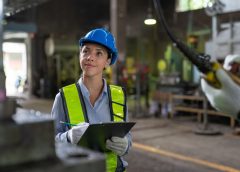By Guilliaume Roeckel
Keeping an eye on the wellbeing of your equipment and machines can greatly improve your sustainability efforts. For example, having preventative maintenance schedules in place can lead to up to 20% savings in raw material usage, as well as a 30% decrease in greenhouse gas emissions. So, if you’re actively trying to become more eco-conscious in your operations, what value can preventative maintenance bring to the table?
Welding Alloys, with expertise in cladding and hardfacing applications, looks at the importance of minimizing equipment downtime to ensure energy is used as efficiently as possible.
Wear parts and components. Whether it is machining equipment, cement plant components or components in the recycling industry, most industries are generally exposed to challenging wear environments.
Many parts and components of machinery experience continuous friction, heat, and stress during operation and will gradually wear out over time. As part of an effective preventative maintenance strategy, these require inspection, maintenance, and repair to delay or avoid costly replacement and to keep the machinery running efficiently. Welding Alloys, a leading expert in cladding and hardfacing applications, highlights the importance of minimizing equipment downtime by repairing components using latest technologies to ensure energy is used as efficiently as possible.
Energy efficiency. One of the most beneficial advantages of keeping your machinery in order is that it can improve your energy efficiency.
Group Product Engineer Pieter du Plessis explained, “Performing constant maintenance checks on your tools and equipment will allow your assets to always operate at the height of their efficiency. Well-maintained machinery tends to consume less energy as everything is ticking as it should. In turn, this will significantly lower your carbon emissions and leave you with a more affordable bill at the end of the month. When comparing the energy requirements of replacement versus the maintenance and repair of components, it is always more beneficial to adhere to preventative maintenance when aiming to improve sustainability goals.
“It’s also worth noting that preventative maintenance to reduce downtime can actively help with resource conservation. Any inefficiencies and hiccups in your processes can waste lots of precious energy, as your assets will need to work twice as hard to overcome the fault and keep operating as usual. So, regular maintenance tasks can nip any potential problems in the bud and promote a more sustainable use of your resources,” he concluded.
Equipment longevity. Looking after the wellbeing of your tools will no doubt increase their life expectancy. In fact, from regular inspections to cleaning and timely repairs, preventative maintenance measures allow you to identify issues before they escalate into bigger, more troublesome problems.
This means that you can monitor your equipment’s health and tackle any hazards on the spot, which will then favor optimal longevity and reduce the need for frequent, pricey purchases.
In this respect, extending the lifespan of your machinery will cut your wastage levels, too. For example, regularly replacing worn-out welding torches with brand-new assets can generate significant waste, putting a dent in your sustainability efforts.
Employee training. Educating people about the impact of downtime on the environment might encourage them to review the performance of their own tools, too.
Fostering a culture of sustainability within the business is a crucial step to make preventative maintenance a priority task on everyone’s agenda. This will empower workers to contribute to the company’s eco-friendly goals, as they will feel the responsibility to promote sustainable behaviors in their operations.
Reduced emissions and water consumption. Preventative maintenance programs can minimize emissions and aid your carbon footprint.
Underperforming machineries tend to emit higher levels of pollutants, affecting the wellbeing of your surroundings. This is particularly relevant in the welding industry, as ill-kept assets can generate fumes and particulate matter.
Conversely, well-maintained equipment is more likely to operate in a clean, effective fashion. By monitoring your machinery’s health and performance, you can avoid leaks, spills, and other malfunctions that could harm the environment.
What’s more, preventative maintenance can help minimize water consumption, too. Every day, just under 3 billion liters of water, equivalent to 1,180 Olympic swimming pools, are lost due to leaks.
However, by monitoring your tools on a regular basis, you can identify and rectify any problems causing water leaks and ensure they’re adequately conserved to drive your operations forward.
Guilliaume Roeckel is global machines sales director at Welding Alloys.

